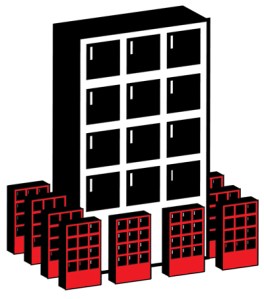Does Size Matter? In an Industry Filled with Goliaths, Davids Abound
By Jotham Sederstrom September 19, 2012 7:30 am
reprintsOn a balmy July afternoon, a few members of SL Green (SLG)’s management staff pushed their way through the revolving doors of 711 Third Avenue, the company’s 500,000-square-foot, 20-floor tower between 44th and 45th Streets.
They passed through the gallery-style lobby, framed by both Greek Thassos white and De Savoi grey-blue marble, carrying a few boxes. An original Hans Hoffman mosaic mural, designed in 1956, adorned the hallway farther down.
They sliced open the boxes and put on green aprons emblazoned with the firm’s stylized logo—and so the ice cream party for the building’s tenants began.
In a market full of haves and have-nots, there are benefits to being the biggest fish in the pond.

SL Green, with more than 24 million square feet of Manhattan office space, is the whale shark of the market, commandeering world-class buildings with more features than a CLS-class Mercedes, and offering clients a whole lot more than Italian ices and chipwiches on a hot day.
But in the sea of buildings across the city, there are plenty of fish awaiting their day to become the predator, and most possess game plans similar to the big guys’.
“We try to buy very well located buildings, and our management strategy is to be very hands-on,” said Kenneth Aschendorf, a principal at APF Properties who oversees the company’s New York portfolio.
APF Properties’ buildings include 28 West 44th Street, a 370,000-square-foot asset the company purchased from SL Green in a joint venture with Prudential (PRU) Real Estate Investors for $161 million in 2011, and 24 West 57th Street, a 110,000-square-foot building in the Plaza district.
“It would be a lot less expensive to outsource the management, but we are very mindful of our tenants’ complaints and experiences,” said Mr. Aschendorf.
APF went a step further to make sure the company was aware of its customer concerns at that building: it became a tenant itself. It leased 5,000 square feet for 10 years on the seventh floor of what is now called the Club Row Building after nearby collegiate clubs Harvard, Cornell, Princeton and Penn.
“We’re going to be renovating all of the common areas, as well as the elevator cabs, bathrooms and windows,” Aschendorf told The Commercial Observer when the move was announced in June 2011.
While the issues the commercial real estate market currently faces affect all property holders, no matter their size, some smaller owners shared a sense of optimism about the varied types of businesses hoping to call the city home.
“New York City has shown some remarkable strengths, which we see reflected in leasing across our portfolio and tenant base, including growth in technology, new media, education, health care and professional services firms,” said Nicholas Bienstock, managing partner of Savanna, which operates 3.4 million square feet of space across Manhattan, including 100 Wall Street and the landmarked 104 West 40th Street.


